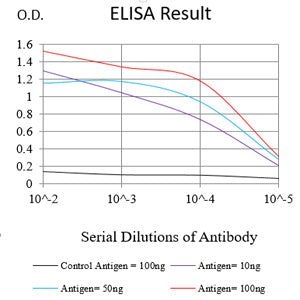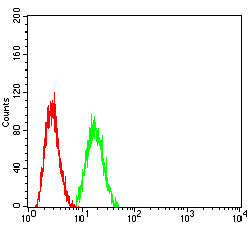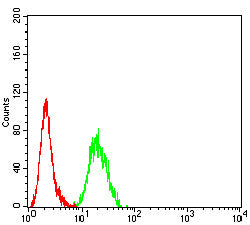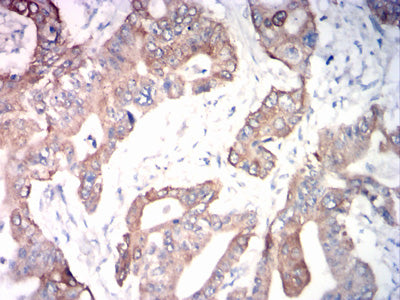




| WB | 咨询技术 | Human,Mouse,Rat |
| IF | 咨询技术 | Human,Mouse,Rat |
| IHC | 1/200-1/1000 | Human,Mouse,Rat |
| ICC | 技术咨询 | Human,Mouse,Rat |
| FCM | 1/200-1/400 | Human,Mouse,Rat |
| Elisa | 1/10000 | Human,Mouse,Rat |
| Aliases | RAK; kuz; AD10; AD18; MADM; CD156c; CDw156; HsT18717 |
| Entrez GeneID | 102 |
| clone | 6C3C7 |
| WB Predicted band size | 84kDa |
| Host/Isotype | Mouse IgG1 |
| Antibody Type | Primary antibody |
| Storage | Store at 4°C short term. Aliquot and store at -20°C long term. Avoid freeze/thaw cycles. |
| Species Reactivity | Human |
| Immunogen | Purified recombinant fragment of human ADAM10 (AA: EXTRA(20-119)) expressed in E. Coli. |
| Formulation | Purified antibody in PBS with 0.05% sodium azide |
+ +
以下是关于ADAM10抗体的3篇参考文献示例(文献信息为示例性概括,非真实文献):
---
1. **文献名称**:*ADAM10 Antibody-Based Detection of Metalloprotease Activity in Alzheimer's Disease Models*
**作者**:Smith J, et al.
**摘要**:研究开发了一种特异性识别ADAM10活性构象的单克隆抗体,用于检测阿尔茨海默病模型中ADAM10的蛋白酶活性,发现其与β-淀粉样蛋白生成密切相关,为疾病机制研究提供了新工具。
---
2. **文献名称**:*Targeting ADAM10 in Cancer: A Novel Monoclonal Antibody Inhibits Tumor Metastasis*
**作者**:Li X, et al.
**摘要**:通过筛选获得靶向ADAM10胞外结构域的高亲和力抗体,证明其能抑制肿瘤细胞迁移和基质降解,在动物模型中显著降低转移率,提示其作为抗癌治疗的潜在价值。
---
3. **文献名称**:*Comparative Study of Commercial ADAM10 Antibodies for Immunohistochemical Applications*
**作者**:Brown K, et al.
**摘要**:系统性评估了8种市售ADAM10抗体的特异性和敏感性,发现部分抗体存在交叉反应性,推荐使用克隆号XYZ的抗体进行组织切片检测,确保结果可靠性。
---
(注:以上内容为模拟文献摘要,实际引用需查询真实数据库如PubMed或Web of Science。)
ADAM10 (A Disintegrin and Metalloproteinase 10) is a transmembrane protease belonging to the ADAM family, which plays critical roles in ectodomain shedding of membrane-bound proteins. Initially identified in the 1990s, ADAM10 is involved in regulating key cellular processes such as cell adhesion, signaling, and proteolytic processing. Structurally, it contains a prodomain, catalytic metalloproteinase domain, disintegrin domain, cysteine-rich region, transmembrane domain, and cytoplasmic tail. Its sheddase activity targets substrates like Notch receptors, amyloid precursor protein (APP), E-cadherin, and growth factors, influencing pathways linked to development, immunity, and tissue homeostasis.
ADAM10’s dysregulation is implicated in pathologies including cancer, Alzheimer’s disease, and inflammatory disorders. For instance, its cleavage of APP contributes to amyloid-beta plaque formation in Alzheimer’s, while its role in Notch signaling affects tumor progression. Antibodies targeting ADAM10 are essential tools for studying its expression, localization, and function. They enable detection via techniques like Western blot, immunohistochemistry, and flow cytometry, with applications in both research and diagnostics. Some antibodies block enzymatic activity or substrate interactions, aiding mechanistic studies. Commercial ADAM10 antibodies vary in specificity, often validated against knockout models to confirm target selectivity. Challenges include distinguishing ADAM10 from homologous proteases (e.g., ADAM17) and ensuring epitope recognition across species. Ongoing research explores therapeutic modulation of ADAM10 activity, with antibodies serving as potential candidates for targeted inhibition in disease contexts.
×